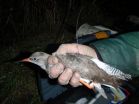(Press-News.org) When herbivores such as caterpillars feed, plants may "call for help" by emitting volatiles, which can indirectly help defend the plants. The volatiles recruit parasitoids that infect, consume and kill the herbivores, to the benefit of the plant. However, such induced plant odours can also be detected by other organisms. A new study published November 27 in the open access journal PLOS Biology shows how secondary parasitoids ('hyperparasitoids') can take advantage of these plant signals to identify parasitoid-infected caterpillars, and duly infect the primary parasitoid, to the detriment of the original plant.
Plant volatiles have long been considered to mediate this mutualistic relationship between plants and herbivores' natural enemies such as parasitoids. When a caterpillar feeds, the parasitoids are able to use the emitted volatiles to locate the otherwise inconspicuous caterpillar, releasing the plant from its attacker. This principle has made its way into sustainable agriculture by using natural enemies such as parasitoids to control herbivorous pests on agricultural crops. However, the largest group of enemies of parasitoids, hyperparasitoids, have so far been left out of studies in this area. This is because very little is known about the cues that hyperparasitoids use to locate their parasitoid hosts.
The new study, by a team of Dutch researchers led by Erik Poelman, shows that hyperparasitoids exploit the different plant odours that are released when a plant is fed upon by a parasitoid-infected caterpillar.
"In controlled laboratory assays as well as under field conditions, hyperparasitoids were offered plant odours coming from two types of plant: ones damaged by healthy caterpillars, and ones damaged by parasitoid-infected caterpillars. We found that they preferentially detected odours of plants damaged by infected caterpillars," explained Dr Poelman. "We were excited by these results as they indicate that hyperparasitoids rely on a network of interactions among plant, herbivore and parasitoids to locate their host".
To show how this complex network of interactions can reliably provide hyperparasitoids with information on the presence of their parasitoid host, the researchers collected saliva of the caterpillars, as they noticed the colour of saliva in healthy, non-host caterpillars was different to that of caterpillars hosting a parasitoid. Factors in caterpillar saliva play an important role in provoking the release of odours from plants, and a change in saliva composition may then alter the cocktail of odours emitted by the plant.
Indeed, Dr Poelman's team found that plant odours induced by the saliva of parasitized caterpillars was more attractive to hyperparasitoids than plant odours induced by the saliva of healthy caterpillars. Consequently, plant odours may actually reduce the benefit of attracting parasitoids to a plant.
"Our results demonstrate that the effects of herbivore-induced plant volatiles should be placed in a community-wide perspective that includes species at the fourth trophic level, to improve our understanding of the ecological functions of volatile release by plants," said Dr Poelman. In addition to the ecological aspects of their work, the authors also stress that their findings are important for developing Integrated Pest Management strategies, in which crops are manipulated to control insect pests by using parasitoids.
Although parasitoids are effective biological control agents, this study suggests that using plant odours to optimize biological control of pests may have side effects that could actually reduce the benefit of pest control, said Dr Poelman.
###Funding: This study was supported by the Strategic Fund of the Graduate School Experimental Plant Sciences (EPS) and the Earth and Life Sciences Council of the Netherlands Organisation for Scientific Research (NWO-ALW) by a Veni Grant 863.10.012 (to EHP), Vici Grant 865.03.002 (to MD) and Ecogenomics Grant 844.10.005 (to FZ). The funders had no role in study design, data collection and analysis, decision to publish, or preparation of the manuscript.
Competing interests: The authors have declared that no competing interests exist.
Citation: Poelman EH, Bruinsma M, Zhu F, Weldegergis BT, Boursault AE, et al. (2012) Hyperparasitoids Use Herbivore-Induced Plant Volatiles to Locate Their Parasitoid Host. PLoS Biol 10(11): e1001435. doi:10.1371/journal.pbio.1001435
CONTACT:
Dr. Erik Poelman
Laboratorium voor Entomologie
Wageningen University
The Netherlands
Tel: +31-317-485433
erik.poelman@wur.nl
The hungry caterpillar: Beware your enemy's enemy's enemy
2012-11-28
ELSE PRESS RELEASES FROM THIS DATE:
Studies examine whether therapies for heart failure are associated with improved survival
2012-11-28
CHICAGO – An analysis of two heart failure therapies finds differing outcomes regarding improvement in survival, according to two studies appearing in the November 28 issue of JAMA.
In one study, Adrian F. Hernandez, M.D., M.H.S., of the Duke Clinical Research Institute, Durham, N.C., and colleagues examined the clinical effectiveness of aldosterone antagonist therapy and associations with long-term outcomes of older patients discharged from a hospitalization for heart failure.
"Aldosterone antagonist therapy [a diuretic drug] for heart failure and reduced ejection ...
Heart failure drug less effective in real world
2012-11-28
DURHAM, N.C. – A large study addressing the effectiveness and safety of aldosterone antagonist therapy for older heart failure patients has found notable differences between the drug's results in clinical trial vs. what occurs in actual practice, according to researchers at Duke Medicine.
Those differences have been noted anecdotally by doctors, and likely contributed to the slow adoption of aldosterone antagonists in clinical practice, but they had not been confirmed in a large study examining the drugs in real-world situations.
The Duke-led research, published Nov. ...
Risk of pertussis increases as time since last dose of DTaP vaccine lengthens
2012-11-28
CHICAGO – In an examination of cases of childhood pertussis in California, researchers found that children with pertussis had lower odds of having received all 5 doses of the diphtheria, tetanus, and acellular pertussis vaccine (DTaP) vaccine series; however the odds increased as the time since last DTaP dose lengthened, which is consistent with a progressive decrease in estimated vaccine effectiveness each year after the final dose of DTaP vaccine, according to a study in the November 28 issue of JAMA.
"Pertussis remains a poorly controlled vaccine-preventable disease ...
Study examines anticoagulation treatment following aortic valve replacement
2012-11-28
CHICAGO – Although current guidelines recommend 3 months of anticoagulation treatment after bioprosthetic aortic valve replacement surgery, a study that included more than 4,000 patients found that patients who had warfarin therapy continued between 3 and 6 months after surgery had a lower rate of cardiovascular death, according to a study in the November 28 issue of JAMA.
"Biological prostheses are preferred to mechanical valves for aortic valve replacement (AVR) surgery in elderly patients older than 65 years because of shorter life expectancy and lack of a need to ...
How infidelity helps nieces and nephews
2012-11-28
SALT LAKE CITY, Nov. 27, 2012 – A University of Utah study produced new mathematical support for a theory that explains why men in some cultures often feed and care for their sisters' children: where extramarital sex is common and accepted, a man's genes are more likely to be passed on by their sister's kids than by their wife's kids.
The theory previously was believed valid only if a man was likely to be the biological father of less than one in four of his wife's children – a number that anthropologists found improbably low.
But in the new study, University of ...
Ecologists shed new light on effects of light pollution on wildlife
2012-11-28
Coasts and estuaries are among the most rapidly developing areas on Earth. Night-time satellite images of the planet show that except Antarctica, continents are ringed with halos of brightly-lit human development. But coasts are also key wildlife sites. Every year, millions of waterbirds arrive from the Arctic to overwinter on UK coasts, yet scientists remain largely in the dark about how these birds respond to the bright lights of coastal cities and industry.
To shed light on the issue, Dr Ross Dwyer and colleagues from the University of Exeter investigated how artificial ...
Sea-levels rising faster than IPCC projections
2012-11-28
Sea-levels are rising 60 per cent faster than the Intergovernmental Panel on Climate Change's (IPCC) central projections, new research suggests.
While temperature rises appear to be consistent with the projections made in the IPCC's fourth assessment report (AR4), satellite measurements show that sea-levels are actually rising at a rate of 3.2 mm a year compared to the best estimate of 2 mm a year in the report.
The researchers, from the Potsdam Institute for Climate Impact Research, Tempo Analytics and Laboratoire d'Etudes en Géophysique et Océanographie Spatiales, ...
Most women who have double mastectomy don't need it, U-M study finds
2012-11-28
ANN ARBOR, Mich. — About 70 percent of women who have both breasts removed following a breast cancer diagnosis do so despite a very low risk of facing cancer in the healthy breast, new research from the University of Michigan Comprehensive Cancer Center finds.
Recent studies have shown an increase in women with breast cancer choosing this more aggressive surgery, called contralateral prophylactic mastectomy, which raises the question of potential overtreatment among these patients.
The study found that 90 percent of women who had surgery to remove both breasts reported ...
Common heart failure drugs could benefit more patients
2012-11-28
Heart failure affects 3 per cent of the overall population, and exists in two forms: reduced ability to contract the heart and reduced ability to relax the heart. The former affects younger patients, mostly men, and is treatable. The latter, called HFPEF (heart failure with preserved ejection fraction), affects older patients and women, and until now there has not been any treatment available against the disease.
In the present study, a team comprising researchers at Karolinska Institutet, Linköping University, Stockholm South General Hospital and Karolinska University ...
Digoxin increases deaths in patients with atrial fibrillation
2012-11-28
Digoxin, a drug that has been used worldwide for centuries to treat heart disease, is associated with a significant increase in deaths in patients with atrial fibrillation (AF), according to results from a study published online today (Wednesday) in the European Heart Journal [1].
Digoxin is extracted from the foxglove plant (digitalis) and it helps the heart beat more strongly and with a more regular rhythm. It is commonly used in AF patients, and also in patients with heart failure. However, it can be problematic to use successfully as there is a narrow dose range at ...


